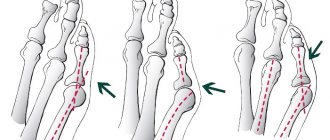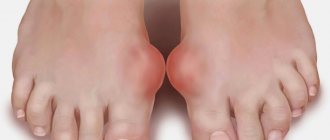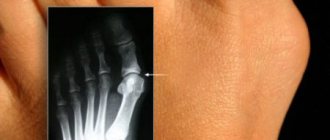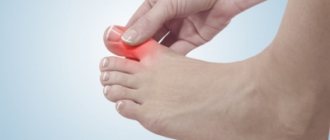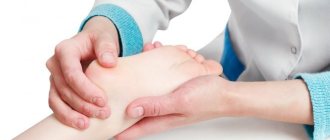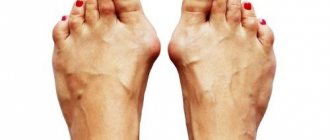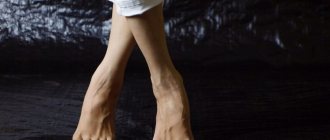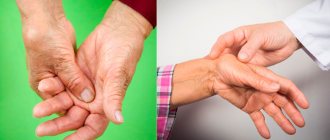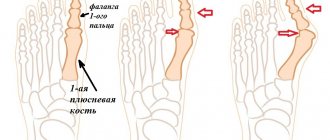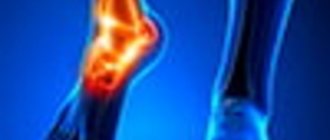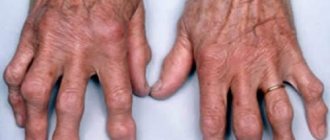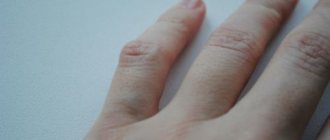From this article you will learn:
- Why does the bunion on my big toe hurt?
- Causes of pain in the bunion of the big toe
- Stages of development of hallux valgus
- 5 ways to get rid of a bunion on your big toe yourself
- Surgical, physiotherapeutic and medicinal treatment of the bunion on the big toe
Sometimes a bunion on the big toe causes discomfort and pain. In fact, this is an alarm bell that can become a harbinger of an unpleasant disease. The so-called callus is most often found in women, because it is the fair half of humanity who often wear heels.
As a rule, at first all symptoms are ignored, and girls are in no hurry to see a doctor. However, if a bunion is not treated, it can lead to serious tissue damage and deformation of the foot. Let's talk in detail about the nature of the disease and treatment methods.
Why does the bunion on my big toe hurt?
As a result of bursitis of the thumb (callus), the joint at its base increases in size and begins to bulge outward, causing a lump to form.
The main reason for this pathology lies in wearing very tight shoes, which provokes an abnormal position of the joint connecting the big toe and the other part of the foot - it enlarges and becomes deformed. As a result, a bone grows on the big toe. This phenomenon is accompanied by pain and swelling.
Often this process is long and painful. Over time, the pain increases. At the first stage of the disease, the finger is turned outward more strongly. Moreover, swelling appears on the outside, the foot acquires an unhealthy reddish color. Then severe pain occurs in the foot when a person stands, puts on shoes, or engages in physical activity.
Men and women are equally susceptible to the disease. But more often a bunion grows on the big toe in women, since few men wear shoes with a narrow toe.
As a result of the disruption of blood flow and changes in the position of the big toe (for example, when wearing high-heeled shoes), the joint becomes deformed as the toes inside the shoes are strongly compressed. As a result of the joint abnormality, the formation of scar tissue and tumors occurs, so the condition of the feet changes.
At first the size of the bone is small. However, if you wear very narrow shoes for a longer period of time, the lump continues to grow. A greatly enlarged bone leads to an increase in the tumor, and, as a result, limitation of movements. Sometimes it is difficult for a person not only to move, but also to stand. According to experts, even if the lump is small, you need to visit a doctor for advice. The effect of treatment directly depends on how early it was started. It must be said that the problem will not disappear on its own. If you do not pay attention to the growing bone, the consequences can be very sad.
If you experience pain in the bunion on your big toe, immediately change uncomfortable tight shoes to looser ones, try to maintain correct posture while walking and running. Sometimes it is necessary to use a supporting corset to ensure the correct position of the spine. In addition, it is important to stretch and regularly treat problem areas with essential oils to combat arthritis. In some cases, these measures can help, but it all depends on the individual characteristics of the body.
Causes of pain in the bunion of the big toe
The appearance of hallux valgus is preceded by a number of circumstances, most of them related to the lack of necessary foot care.
The main reasons for the appearance of a bone at the base of the thumb:
- incorrectly chosen or poorly made shoes - mostly these are too tight shoes that significantly compress the foot;
- improper diet, as a result of which the body does not receive a full set of nutrients - pathology can also arise due to an excess of any elements;
- heredity - if someone in the family already had such a problem, then hallux valgus deformity is highly likely to appear;
- the presence of diseases of the musculoskeletal system;
- insufficient physical activity.
Women are 10 times more likely than men to suffer from hallux valgus, as their bodies are more strongly influenced by hormones. In addition, women have a more flexible ligamentous apparatus, which also has a great influence on the growth of the bone.
On a note! Representatives of the fair sex, in pursuit of fashion trends, often wear very uncomfortable shoes, although they are spectacular. Following the rule “beauty requires sacrifice,” the female half of humanity significantly (literally several times) increases the risk of bursitis. Currently, 40% of women in the world are faced with this problem.
Very often the joint is deformed due to excess weight, flat feet, frequent and prolonged walking, and diseases of cartilage tissue.
The disease is often diagnosed in people who professionally engage in gymnastics and dancing, as well as in those who must stand on their feet for a long time. Sometimes women observe the development of pathology during pregnancy or menopause, since at this time a hormonal imbalance occurs in the body. In some cases, the bunion begins to grow due to a leg injury.
It happens that children suffer from hallux valgus, although very rarely. This occurs due to the presence of diseases: rickets, poliomyelitis, excessive joint mobility.
Bone growth occurs in those who suffer from gout and arthritis. Quite often, hallux valgus is confused with other diseases, despite the presence of characteristic symptoms. Therefore, only a doctor can accurately make the correct diagnosis.
Mechanism of damage
Two mechanisms of damage have been proposed:
- Plantar flexion and inversion injuries: During rapid plantar flexion and inversion injuries (a mechanism of lateral ankle sprain), a strong reflex contraction of the peroneus longus muscle occurs. In this case, the cuboid bone acts as a center of rotation, and the tendon transfers the load to the cuboid bone, causing inferomedial displacement, in other words, subluxation of the cuboid bone.
- Overuse syndrome: This mechanism is poorly described and rare, but it has been suggested that cuboid subluxation occurs secondary to repeated microtrauma (in case of return to vigorous activity).
Predisposing factors:
- instability of the articulation of the tarsal bones with each other;
- excess body weight;
- ill-fitting or poorly designed orthoses or shoes;
- physical exercise (intensity, duration, frequency);
- training on uneven surfaces;
- sprained foot or ankle;
- Cuboid syndrome may be more prevalent in patients with pronated feet due to increased leverage of the peroneus longus muscle.
Stages of development of hallux valgus
| Stage | Symptoms |
| 1 | At this stage of the disease, there are practically no complaints of pain. However, the thumb moves approximately 20 degrees from its normal position |
| 2 | This stage is characterized by more noticeable displacement and the appearance of primary, quickly passing pain, which is usually not noticed. Most often, painful sensations appear after a person has covered a long distance on foot. |
| 3 | At this stage, the finger has already shifted 30–50 degrees from its normal position. The pain becomes severe and increases when putting on shoes. Immobilization of the joint occurs. The pain is very disturbing when walking for a long time |
| 4 | The thumb angle is more than 50 degrees. The person feels severe pain all the time. Calluses, corns, and inflammations become its integral companions. |
It is necessary to visit a doctor already at the first stage, since in this case the treatment of the bunion on the big toe will be much more effective and painless. At the very beginning of the disease, it is possible to eliminate the problem yourself, using folk recipes or special medications. At the last stage, mandatory medical intervention is required, and in some cases only surgery helps.
Recommended articles on the topic:
- How to massage the abdomen for weight loss: different techniques for health and beauty
- Stone massage: description, benefits, methods
- MRI of three parts of the spine: when is it necessary and what are the features of the procedure
Surgical, physiotherapeutic and medicinal treatment of the bunion on the big toe
There are many methods to get rid of this problem. When choosing a correction method, the specialist is guided by the degree of neglect of the disease, the patient’s health status and other factors.
After examining the person seeking help and analyzing the situation, the doctor will make a diagnosis and recommend the following methods:
- Use of anti-inflammatory drugs. You can treat a bunion on your big toe with ointments, tablets and other medications. Only a doctor can prescribe medications to eliminate the inflammatory process. You cannot self-medicate, as some medications have contraindications. These drugs have side effects that can lead to serious consequences and only make the situation worse.
- Physiotherapeutic procedures. Sometimes using these methods you can get rid of hallux valgus. The use of therapeutic mud, electrophoresis, and baths helps improve blood flow, metabolism, tissue restoration, and relaxation of leg muscles. All physiotherapeutic measures must be prescribed by a doctor.
- Surgery on the big toe to get rid of a bunion is usually used at the last stage of the disease and only in extreme cases. Moreover, the surgical method will help get rid of the problem. However, there is always a risk of relapse if you forget to care for your feet and do not take preventive measures. During the operation, the shape of the fingers is straightened. The rehabilitation period after removal of sutures is 2–3 weeks. It must be said that the surgical method is not suitable for vascular diseases and diabetes.
If swelling appears not only on the big toe, but also on other toes and it persists for a long time, it is recommended to consult a specialist. This must be done even if you do not feel pain. The occurrence of discomfort and swelling in the toes may indicate the presence of arthritis, osteoarthritis, or bursitis. It is not recommended to stop treatment after removing the bone. It is necessary to wear loose-fitting shoes and use natural remedies for another two months.
Why clients choose Veronika Herba Beauty and Health Center:
- This is a beauty center where you can take care of yourself at a reasonable cost, while your face and/or body will be treated not by an ordinary specialist, but by one of the best in Moscow. This is a completely different, higher level of service!
- You can receive qualified help at any time convenient for you. The beauty center is open from 9:00 to 21:00, seven days a week. The main thing is to agree with your doctor in advance on the date and time of your appointment.
Sign up for a consultation with a specialist by phone +7 (495) 085-15-13
, and you will see for yourself!
Clinical manifestations
The symptoms of cuboid syndrome resemble those of a sprained ligament. Pain is often dispersed along the lateral aspect of the foot between the calcaneocuboid joint and the 4th and/or 5th cuboid-metatarsal joints and may spread throughout the entire foot. A subtle groove on the dorsum of the cuboid and/or a subtle bump (thickening) on the plantar surface may be seen with subluxation with skin redness, swelling and/or bruising. Tenderness may occur along the peroneus longus muscle, the cuboid groove, the posterolateral and/or plantar orientation of the cuboid, or the origin of the extensor digitorum brevis muscle. Active or passive range of motion of the ankle and/or foot may be reduced with pain. Resistance of the ankle/foot eversion/inversion may cause pain. In SCS, there is an antalgic gait with pain and/or weakness, most pronounced during push-off or when moving from side to side. Jumping can cause symptoms that increase with weight bearing and decrease when weight is removed.
